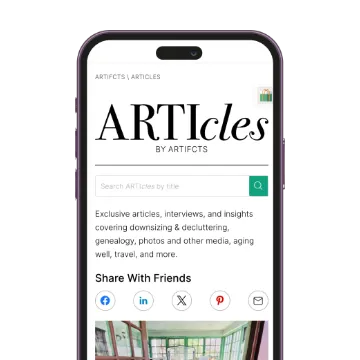The holidays leave behind more than sweet memories and leftover cookies—they often leave behind piles of holiday cards, envelopes, and handwritten sentiments that can accumulate year after year. Many of us have bins tucked away in closets filled with cards we think we’ll revisit someday. But what if there was a better way to preserve the heartfelt thoughts without keeping a mountain of paper?
At Artifcts, we believe you can keep the memories and reduce the clutter creating a win-win for all. Read on to learn how to give your holiday cards a second life that actually honors the story behind them.
Rethink What You’re Really Saving
Holiday cards are meaningful because of the thought and connection behind them—not because of the paper they’re printed on. Most cards are never meant to be kept forever, yet many of us hang onto them like keepsakes.
According to a recent article in the New York Post, 85 percent of Americans say they will not throw away their holiday cards this year, with the average reader claiming to have 17 cards. We get it! We like seeing our loved ones’ handwriting, and we love looking back at the old photos and re-reading the funny stories contained within. The beauty of Artifcts though is that you can capture the memory and meaning before letting go of the physical card.
Step-by-Step: From Card Clutter to Meaningful Memories
- Artifct the Best Ones
Take a photo of your favorite holiday cards—the ones with truly personal, handwritten messages or special photos. Upload the images to Artifcts and add a story or description: who sent it, what the message meant to you, and why it stood out. You can even add audio or video too. This way, you preserve the heart of the card forever, even if the paper gets recycled later.
 One of our co-founder Heather's favorite holiday cards. Sorry, this Artifct is private!
One of our co-founder Heather's favorite holiday cards. Sorry, this Artifct is private!Pro tip #1: Consider grouping cards by year or theme (e.g., “Holiday 2025”) so you can see how handwriting, designs, and messages change over time. Add a custom, private tag to the grouping so you can easily sort and search through your collection years from now. Our co-founder Heather uses a tag #frommattwithlove to quickly find the cards her husband has sent her over the years.
Pro tip #2: Feeling overwhelmed by the number of cards? Group the photos into a single PDF and upload the PDF to Artifcts thus creating a single Artifct for all your cards this year.
- Let Go Without Guilt
Once you’ve preserved the memory with Artifcts you can recycle generic or less meaningful cards and maybe keep only a few select physical favorites if you really want. Downsizing your card collection from 17 (!) to three creates a more manageable, meaningful collection. This approach keeps holiday clutter under control while also preserving the memories, without bins and boxes taking over your home.
It also helps you avoid the bin of forgotten cards. How many of us have that bin? And when was the last time we looked at it? Feelings of guilt around tossing holiday cards are common but holding onto every single one can quickly become a burden rather than a joy.
Creative Ways to Give Cards New Life
Feeling creative? Hate the thought of simply recycling your old cards? If you enjoy repurposing things physically, here are some fun ways to reuse parts of old cards in lieu of recycling them:
- Cut out decorative fronts to make gift tags
- Use images in a holiday scrapbook (with your Artifcts QR code inside!)
- Repurpose card pieces in crafts or family projects
- Donate card fronts to local schools or nonprofits that reuse them
These ideas let you enjoy the look and feel of your cards without storing them all year long AND ensuring the paper that they were printed on is kept out of a landfill.
Make It a Holiday Habit
In case you missed last week's ARTIcle, it should come as no surprise that we're all about habits here at Artifcts. Next time you finish celebrating (be it a birthday or a holiday), take a moment to Artifct your favorite cards. In a short time, you’ll have a beautiful digital collection of holiday love that you can revisit and share anytime with family, inspire future generations, or simply enjoy reflecting on year after year.
###
Old cards, photos, and letters on your mind? You might also enjoy these related ARTIcles:
What Should You Do with Old Scrapbooks?
Rescue Mission! That's More Than a Photo
How to Artifct Cards & Letters
© 2026 Artifcts, Inc. All Rights Reserved.
















